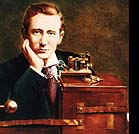1946 The Computer
2000? Mobile Phones
WIRELESS TELEGRAPHY.
MR MARCONI'S TRIUMPH.
WIRELESS MESSAGE ACROSS THE ATLANTIC.
HOW IT WAS ACHIEVED.
 Mr Marconi |
In that short cablegram Mr Marconi announced on Saturday that he had received at Newfoundland wireless messages transmitted across the Atlantic from the Marconi station at the Lizard. The event is of momentous importance, for it is the most wonderful achievement of telegraphy since the introduction of the submarine cable half a century ago.
So far the messages consist merely of prearranged signals, but they prove once for all that it is possible to communicate without wires over the wide expanse of the Atlantic. Major Flood Page, of the Marconi Wireless Telegraph Company, who made an interesting statement last night, describing the experiment, is confident that the rest is a mere matter of patient development. The success of the trials is abundantly proved by Major Flood Page and by the subjoined cablegram from our correspondent at St. John's.
MR MARCONI'S EXPLANATION.
ST JOHN'S (Newfoundland), Sunday, Dec. 15.
Mr Marconi, who is here, announces that he has received wireless signals from the Lizard, Cornwall, a distance of 1,740 miles, thereby demonstrating the feasibility of wireless telegraphy across the Atlantic Ocean.
The message received was merely a signal, the letter S, but according to Mr Marconi it came to him again and again.
In announcing the success of his experiments Mr Marconi explained that the electric force generated at the Poldhu wireless station in Cornwall is a hundred times greater than at the ordinary wireless stations.
During certain hours on Wednesday Mr Marconi elevated a kite with an aerial wire, by means of which the signals are sent or received. He remained at the recorder and received the signals according to the programme previously arranged with the operator at Poldhu.
These signals consisted of repeating at intervals the letter S, which in the Morse code is made by three dots or quick strokes. This signal was repeated so frequently, and according to the detailed plan arranged to provide safeguards against the possibility of mistake, that Mr Marconi says he is satisfied it was a genuine transmission from England.
MESSAGE TO THE KING.
Again on Thursday the kite was elevated and the signals renewed. This made the assurance so complete that Mr Marconi cabled to his principals in England, and informed the Governor of Newfoundland, Sir Cavendish Boyle, who notified the British Cabinet of the success of the experiments.
Mr Marconi also asked Sir Cavendish to apprise King Edward.
Mr Marconi said that he received the signals himself in the Morse characters in three dots repeated at intervals of 10 minutes on the telephone attachment of his instrument, instead of on the tape recorder, the ear being much more sensitive than any automatic instrument. The signals were better on Wednesday than on Thursday.
He tried to keep the kite up on Friday, but adverse winds baffled him, and the same ill-success continued on Saturday.
Mr Marconi will try again on Monday, when if he is successful he will give out the result, but he has no doubts that wireless telegraphy across the Atlantic is perfectly feasible.
In view of the success attending these trials Mr Marconi will for the present disregard the matter of communicating between Transatlantic steamers, and will return to England this week and conduct experiments from Poldhu himself.
He explains that the greater electrical power there will enable him to send more effective signals.
The installation of the plant here will be advanced, and every ship crossing the Atlantic equipped with the system will be reported daily.
1,740 MILES OF SEA
Major Flood Page said a month ago Mr Marconi, accompanied by two assistants, sailed from Liverpool for Newfoundland. His intention, carefully concealed, was to endeavour to telegraph across the Atlantic without wires. In that he has succeeded, having been in communication with the English coast.
When he came to England in 1896 and took out his first patent, the greatest distance to which he could send messages without wires was two miles He gradually increased the distance until fifty, sixty, and then a hundred miles could be bridged.
On the first day of the reign of King Edward messages were sent from the Isle of Wight to Penzance, a distance of 200 miles. Subsequently 350 miles were covered, from Poole, in Dorset, to Crook-haven at the south-west corner of Ireland.
After this last success Mr Marconi became confident of his power to bridge still greater distances. At the Penzance experimental station a great circle of twenty poles, each 150ft high and bearing an aerial wire, was set up, and provision made for the production of powerful electric impulse.
Then Mr Marconi and his two principal assistants carried them to Newfoundland, braving the bitter winter of that inhospitable land in the pursuit of success, and taking with them balloons and kites to lift their receiving wires to the requisite height.
At Penzance other assistants have since the arrival of Mr Marconi on the other side of the Atlantic, at prearranged times and intervals, sent agreed-upon signals from the great circle of aerial wires, and it is these signals which have traversed 1,740 miles of ether and have been recorded on the receiving instruments at St. John's.
At Cape Race, in Newfoundland, an installation similar to that at Penzance is being prepared. When this is ready for work permanent and regular communication across the Atlantic will be established. And if across the Atlantic then across the Pacific also, and round the world.

